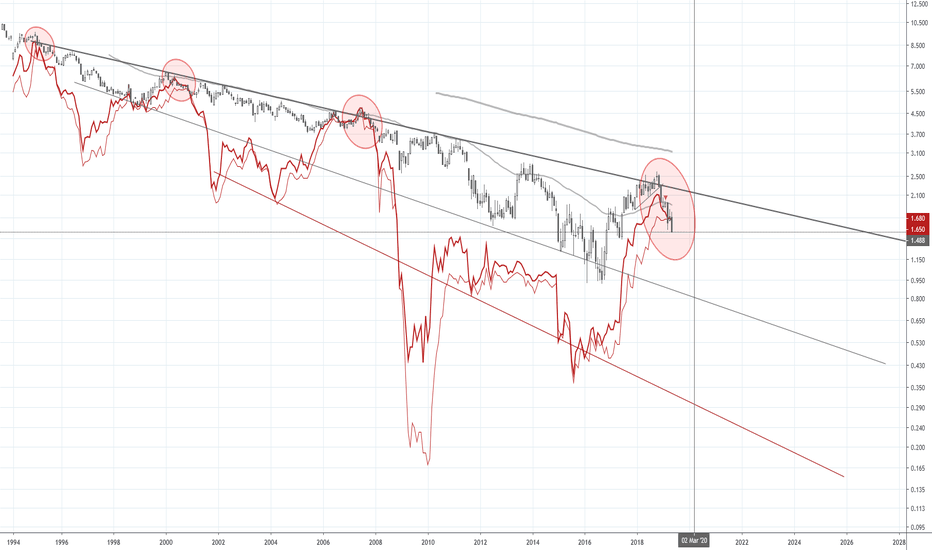ridethepig | Breakout in Canadian 10Y YieldsWe are going to intentionally cycle through many Yield chart updates, which will be rolled out over the next few days. The game of currency speculation must include Yield analysis to have a compromising effect.
It is evident that the exchange in control at the 0.48x lows has lead to a change in momentum. Buyers have forced the technical break and negated the current downtrend, this is a loud warning sign that sellers need to start treading more skilfully. The directional change means buyers must now advance towards 0.85x and 1.07x and absorb the remaining pressure. Gaining tempo with the breakout cannot be dismissed with a quick shrug of the shoulders either!!
Buyers have shown courage, intentionally forming a basing pattern at the 0.48x lows and have completely outplayed late sellers. Look to target 0.85x and 1.07x for the second half of 2020. Depending on the handling of the recovery we can explode to the topside here and unlock 1.325 and 1.844. We can come back to this idea when our wheat blooms.
Good luck and thanks as usual for keeping the support coming with likes, comments, charts, questions and etc!
CA02Y
Canada | Bond Yeilds and Recession WatchLooking at the chart we can see the 3 month yield inverted with the 10 year yield a few weeks ago so recession could be anywhere from 12-18 months out. The question is, where do we stabilize in this current down swing? Things will probably go sideways for a while before we break support and rates dive to zero. The catalyst will be nGDP figures and Bank of Canada policy.
Canada | Recession WatchThe 10 year Canadian yield is now below the 1 year and 3 month yield, which is a good indicator of a potential recession ahead. Rates follow economic growth, so we can interpret yields as a function of the economy. These interest rates also impact the price of money (CAD interest rates). One way to interpret lower interest rates in the Canadian economy is that economic activity is lower and cheap money indicates a discount on loans due to a lack of credit demand. Lack of credit demand could be an issue related to demand itself, access, or credit worthiness. So lower interest rates can quickly impact CAD valuations against other currencies in the FX market.
The trend is pretty clear going back to the early 90s; the 10 year provides a kind of ceiling for yields. There is a kind of megaphone pattern as well, which could indicate that rates will go sharply lower in the coming years, with short term rates bottoming out hard and perhaps even going negative.
Gov't Bond Yields & Bank StocksFollowing government bond yields can be crucial to understanding the underlying price action of banks stocks. Take this example of Canadian bonds and stocks. We can clearly see how, following a steady expansion in yields of various maturities, a trend break where bonds suddenly appreciated (yields go down when bond prices go up) the results were a change in trend for the bank stock (in this case CIBC). The inversion of the 3 month and 10 month yields resulted in a trend change confirmation on the smaller timeframes. This is not just a coincidence: bank business models are heavily influenced by their central bank regulator.
CA10Y | Rate Cuts Ahead for Canada. Watch the Banks!Back in November (2018) the yield on the 10 year Canadian treasury hit the upper boundary historical trendline and reversed sharply after briefly overshooting. Fundamentally, interest rates follow GDP figures so we can use these technicals to give us a bit of a prognoses for the financial and economic wellbeing of the country... and its not looking good.
Today the central bank confirmed the fears so expect Canadian rates to drop across the board (but I expect spreads to rise between safe paper and junk). It will be interesting to watch what happens to bank stocks over the next 12-18 months as the economy slows down. Will we see a credit crunch? How will this impact the Loonie versus the US dollar?
I am expecting trouble for Canadian banks as they are now dealing with a red hot housing market, the rout in commodities, and now, rising consumer delinquencies. Most importantly, bank capital (equity) will likely get squeezed, which will put tension on bank balance sheets and their eagerness to extend credit. A policy for negative interest rates is already primed and ready in the Bank of Canada's toolbox. But luckily Canada doesn't have "reserve requirements" for banks ;)
***This is not investment advice and is simply an educational analysis of the market and/or pair. By reading this post you acknowledge that you will use the information here at YOUR OWN RISK




